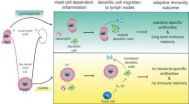(Press-News.org) Babies as young as seven months can distinguish between, and begin to learn, two languages with vastly different grammatical structures, according to new research from the University of British Columbia and Université Paris Descartes.
Published today in the journal Nature Communications and presented at the 2013 Annual Meeting of the American Association for the Advancement of Science (AAAS) in Boston, the study shows that infants in bilingual environments use pitch and duration cues to discriminate between languages – such as English and Japanese – with opposite word orders.
In English, a function word comes before a content word (the dog, his hat, with friends, for example) and the duration of the content word is longer, while in Japanese or Hindi, the order is reversed, and the pitch of the content word higher.
"By as early as seven months, babies are sensitive to these differences and use these as cues to tell the languages apart," says UBC psychologist Janet Werker, co-author of the study.
Previous research by Werker and Judit Gervain, a linguist at the Université Paris Descartes and co-author of the new study, showed that babies use frequency of words in speech to discern their significance.
"For example, in English the words 'the' and 'with' come up a lot more frequently than other words – they're essentially learning by counting," says Gervain. "But babies growing up bilingual need more than that, so they develop new strategies that monolingual babies don't necessarily need to use."
"If you speak two languages at home, don't be afraid, it's not a zero-sum game," says Werker. "Your baby is very equipped to keep these languages separate and they do so in remarkable ways."
###
NB: For more UBC news from AAAS 2013, visit aaas.ubc.ca or follow @ubcnews.
Bilingual babies know their grammar by 7 months
2013-02-14
ELSE PRESS RELEASES FROM THIS DATE:
First animal model of recent human evolution
2013-02-14
The first animal model of recent human evolution reveals that a single mutation produced several traits common in East Asian peoples, from thicker hair to denser sweat glands, an international team of researchers reports.
The team, led by researchers from Harvard Medical School, Harvard University, the Broad Institute of MIT and Harvard, Massachusetts General Hospital, Fudan University and University College London, also modeled the spread of the gene mutation across Asia and North America, concluding that it most likely arose about 30,000 years ago in what is today ...
Defect in immune memory may cause repeat bladder infections
2013-02-14
DURHAM, N.C. – Recurrent bladder infections, which are especially common among women, may result from a defect among the bladder's immune fighters that keeps them from remembering previous bacterial infections. The immune memory lapse can hamper a timely and effective attack, according to researchers at Duke Medicine and Duke-National University of Singapore.
Their study, which involved mice, may provide a new route to develop vaccines and treatments for urinary tract infections, which are the second-most common infection and account for more than 8 million health care ...
Discovery in HIV may solve efficiency problems for gene therapy
2013-02-14
A research team from Case Western Reserve University School of Medicine has discovered an approach that could make gene therapy dramatically more effective for patients.
Led by professor Eric Arts, PhD, the scientists discovered that the process of gene therapy is missing essential elements thereby reducing the effectiveness of this treatment. Re-introducing this element into their model system suggests that improvements for gene therapy areon the horizon.
The findings are detailed in the article, "A new genomic RNA packaging element in retroviruses and the interplay ...
Study tracks leukemia's genetic evolution, may help predict disease course, tailor care
2013-02-14
BOSTON AND CAMBRIDGE, Mass.––Tumors are not factories for the mass production of identical cancer cells, but are, in reality, patchworks of cells with different patterns of gene mutations. In a new study, researchers at Dana-Farber Cancer Institute and the Broad Institute show, more fully than ever before, how these mutations shift and evolve over time in chronic lymphocytic leukemia (CLL) – providing a strobe-like look at the genetic past, present, and future of CLL tumors.
Their report, which will be published online today by the journal Cell, suggests that evolution ...
Gene invaders are stymied by a cell's genome defense
2013-02-14
Gene wars rage inside our cells, with invading DNA regularly threatening to subvert our human blueprint. Now, building on Nobel-Prize-winning findings, UC San Francisco researchers have discovered a molecular machine that helps protect a cell's genes against these DNA interlopers.
The machine, named SCANR, recognizes and targets foreign DNA. The UCSF team identified it in yeast, but given the similarity of yeast and human cells, comparable mechanisms might also be found in humans, where they might serve to lower the burden of inherited human disease and death, the researchers ...
Environment schemes for kids influence parents' behavior
2013-02-14
Teaching children about the environment can affect the knowledge and behaviour of their parents, according to new research.
Scientists from Imperial College London surveyed the families of 160 schoolchildren in the Seychelles, some of whom took part in educational activities about the island's valuable wetland resources.
They found that the parents of children who took part in the wetland activities were more knowledgeable about wetlands and, were more inclined to undertake 'environmentally friendly' behaviours such as conserving water in their homes.
The findings ...
Our primitive reflexes may be more sophisticated than they appear, study shows
2013-02-14
Supposedly 'primitive' reflexes may involve more sophisticated brain function than previously thought, according to researchers at Imperial College London.
The Vestibular-Ocular Reflex (or VOR), common to most vertebrates, is what allows us to keep our eyes focused on a fixed point even while our heads are moving. Up until now, scientists had assumed this reflex was controlled by the lower brainstem, which regulates eating, sleeping and other low-level tasks.
Researchers at Imperial's Division of Brain Sciences conducted tests to examine this reflex in left- and right-handed ...
Indian plant could play key role in death of cancer cells
2013-02-14
AUGUSTA, Ga. – Scientists at the Georgia Regents University Cancer Center have identified an Indian plant, used for centuries to treat inflammation, fever and malaria, that could help kill cancer cells.
Cancer cells typically avoid death by hijacking molecular chaperones that guide and protect the proteins that ensure normal cellular function and then tricking them into helping mutated versions of those proteins stay alive, says Dr. Ahmed Chadli, a researcher in the Molecular Chaperone Program at the GRU Cancer Center and senior author of the study named the Journal ...
New LA BioMed research identifies effective treatment for common gynecological problem
2013-02-14
LOS ANGELES (Feb. 14, 2013) – New research from the Los Angeles Biomedical Research Institute (LA BioMed) found a progestogen-only treatment halted bleeding in women suffering from extremely heavy periods, according to the study published online by the American Journal of Obstetrics and Gynecology.
"Excessive uterine bleeding is a common problem we see in gynecological practices and emergency rooms. It can interfere with women's daily activities and put them at risk for anemia and other more serious health consequences caused by blood loss," said Anita L. Nelson, MD, ...
Love of musical harmony is not nature but nurture
2013-02-14
Our love of music and appreciation of musical harmony is learnt and not based on natural ability – a new study by University of Melbourne researchers has found.
Associate Professor Neil McLachlan from the Melbourne School of Psychological Sciences said previous theories about how we appreciate music were based on the physical properties of sound, the ear itself and an innate ability to hear harmony.
"Our study shows that musical harmony can be learnt and it is a matter of training the brain to hear the sounds," Associate Professor McLachlan said.
"So if you thought ...




